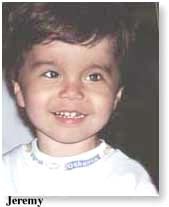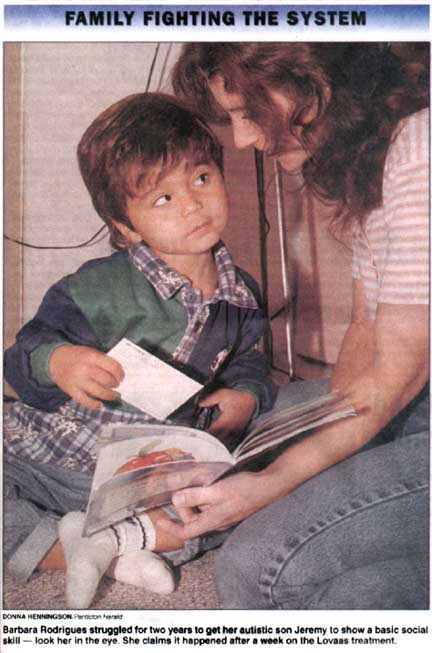 "BC Ministry for Children Abandons Boy with Autism"
"BC Ministry for Children Abandons Boy with Autism"
 "BC Ministry for Children Abandons Boy with Autism"
"BC Ministry for Children Abandons Boy with Autism"
Penticton Herald Front Page Story and A3 articles on Jeremy Rodrigues
DONNA HENNINGSON/Penticton Herald

Funding cut off for autism care
Penticton mother swears by alternative treatment for her autistic son, but province won't pay for it while new plan for autism treatment is being studied
By DONNA HENNINGSON
Penticton Herald Friday, November 6, 1998
Barbara Rodrigues says the province is penalizing her and her autistic son for the actions of other parents who are taking the province to court over funding.
"I don't know why we are being punished for helping our child," said the Penticton mother. "I told the social worker the government has nothing to offer me at this point, but money."
Rodrigues was picketing the Kelowna Ministry for Children and Families office recently, and walked the sidewalk in front of Penticton's Cherry Lane Shopping Centre, to raise awareness of her plight.
Until a month ago, the Ministry for Children and Families (MCF) was giving families like the Rodrigueses $1,000 a month for what the ministry called "in-home day care."
The ministry helps pay for day care already available in the community and such support as behaviour consultants, speech language workers and occupational therapists.
But some families have decided alternative treatments such as the Lovaas method better meet their children's needs.
In Jeremy's case, Rodrigues says she has letters from his pediatrician and family physician stating the treatment is a preferable alternative for him.
The $1,000 allocation is a quarter of the $4,000 a month the Rodrigueses are paying to have Jeremy undergo the behaviour-modification program.
Almost a year ago, the Rodrigues' started experimenting with the Lovaas autism treatment out of Los Angeles. Five months ago, they began the treatment in earnest. It doesn't come cheap.
Lovaas will cost the couple a minimum of $40,000 a year. Currently, Lovaas trainers are all based in the United States.
Barbara Rodrigues and three Penticton students received training in the technique, which involves intensive monitoring of her son Jeremy's actions 36 hours a week. Every three months, a Lovaas trainer analyses progress and fine-tunes the steps.
This fall, what seemed like a workable funding arrangement with MCF fell apart.
In two cases unrelated to the Rodrigues story, the government faced lawsuits from Lower Mainland families seeking funding for Lovaas and other alternative treatments.
The province has withdrawn funding.
"At this point in time, provincial bodies are meeting with autism representatives about an overall plan for everyone in the province that is to be tabled later on in the fall," said MCF area manager Doug Hughes. "At this point in time, we do not have authority to do individualized funding for Lovaas treatment."
In Surrey, Michelle Auton is taking the government to court in a class-action suit on behalf of 120 B.C. families. The Rodrigueses are not one of them.
Auton says Lovaas has been scientifically proven to be the best treatment for autism. On that basis, she claims it should be mandatory and the province should pay for it.
The Autistic Society of B.C. says Lovaas is but one of several forms of treatment that may be right for a child. The problem is a lengthy waiting list for even generic services in a community.
"These families are really desperate," said program director Deborah Pugh. "They are faced wherever they go with a wait list, or treatment inappropriate for the autism spectrum."
The tendency is to slot autism into special needs, said Pugh, and send a child to the neighbourhood special needs day care regardless of whether or not staff are trained for autism.
"I'm not saying kids should go to a segregated situation," said Pugh. "But they should go to a situation where staff can offer a meaningful program."
A small-scaled structured program with visual symbols, that walks a child carefully through daily activities has a good chance of making inroads.
"It take a lot of training," she said. "You can't expect a neighbourhood day care to know to do that.
"In my experience a lot of families come to us complaining they were never made aware of the programs available to children on the autism spectrum," said Pugh.
Lovaas is not for everyone, Pugh pointed out. Some do well; others don't.
"We would like the government to look at cases individually regarding funding, if they can make a case and show some data, such as that there is an increased language use, or decreased temper tantrums."
See also LOVAAS/page A3
'Lovaas' treatment brightens young eyes
By DONNA HENNINGSON
Penticton Herald Friday, November 6, 1998
It started when her son was a year old. Barbara Rodrigues and her husband Joe thought they had a healthy baby boy.
But Jeremy's gross motor skills were developing slowly. He was big at 37 pounds, though other members of the family had been, too.
Then Jeremy started to slip away from them.
"He had a red rattle he liked," said Barbara. "We would say 'okay, go get the red rattle.' Over a period of time he didn't seem to know what we were saying."
Jeremy would sit spinning the wheels on a toy, and would scream if Joe interrupted him for a hug. A stranger coming in the front door would trigger hours of screaming.
Test found nothing physically wrong, but medical authorities suggested autistic tendencies. Even so, the Rodrigues' said they were led to believe he would grow out of it.
Jeremy to go to the OSNS Child Development Centre, working with a behaviour consultant, but according to Barbara his behaviour was getting worse.
Jeremy slept only in spurts, and would kick and scream when she tried to dress him.
He started pulling out his hair in frustration, and was losing the few words he did know.
It was by inadvertently reading a letter in his medical file that Barbara found out he had been diagnosed as autistic.
A November 1997 conference in Edmonton on sensory integration appeared to confirm there was little hope for Jeremy. Rodrigues cries at the memory.
"There were 10- and 13-year-old boys with no language and a lot of aggression," she said. "I came home and was so depressed. My mom said "I can't believe that is all there is,' and started getting books from the library. She would find something and read me a paragraph over the phone.
It was enough to give Rodrigues hope, and through her own research she found what appeared to be the answer, the Lovaas treatment. Her mother calls it "the day the lights when on in Jeremy's eyes."
For two years, every effort to build eye contact with Jeremy eluded them. But shortly before Christmas 1997, they tried carefully timed smiles and encouragement. Within a week of intensive reinforcement, they say, he was looking them in the eye.
Barbara was heartened by the success, and decided Jeremy needed more intensive help than what the OSNS was equipped to offer.
"The methods used are good for delayed kids, and other disabilities," she said. But autistic kids don't learn that way."
The following March, this time at a Lovaas conference, Barbara saw severely autistic young people talking, socializing, even tying shoelaces.
Almost six months into Lovaas, although expressing himself continues to be difficult, Jeremy is making strides in vocabulary. Five months ago, it took him a month to learn "banana." It has taken him less than three weeks to identify 20 letters in the alphabet.
He now can identify 150 nouns.
"He gets everything quicker than I probably could," said Angalee Evans, one of three students specially trained in Lovaas to work with Jeremy. "He is picking up two verbs a day now."
B.C. government yet to endorse treatment

Barbara Rodrigues picketed the Ministry for Children and Families office and walked the sidewalk in front of Penticton's Cherry lane Shopping Centre, to try and raise awareness of her plight.
By Penticton Herald Staff
Friday, November 6, 1998
Autistic children are especially sensitive to everything around them.
What they touch, see, hear and smell can send them into a spiral at a moment's notice.
It's a neurological disorder with no known cure. But behaviour can be dramatically altered if diagnosed in the first three years.
To an autistic child, what people say and do make little sense. Much of their acting out is from frustration at being unable to communicate with or understand others.
The spin objects and do other repetitive actions to comfort themselves.
"Little kids usually point and gesture and explore things," Barbara Rodrigues, parent of an autistic child, explained. "They want to interact, and are curious. An autistic child does none of that."
Treatment generally means gradually re-introducing the child to objects and other people.
By doing so, the child builds a vocabulary and social skills. Expressing oneself tends to happen last.
What makes the Lovaas treatment unique is its intensity. The treatment is named for the work of Dr. O. Ivar Lovaas of the University of California, in the 1960s.
Every action is broken down into smaller steps and presented in a very specific manner. The problem is knowing just when and how to reinforce a child's efforts.
"It's a science of minor detail, this," explained Rodrigues.
The Rodrigues' are one of several families who have formed Families for Early Autism Treatment (FEAT).
Their goal is to have every B.C. toddler tested for autism. They also want the province to fund Lovaas as the most scientifically proven treatment for autism.
Spokesperson Dr. Sabrina Freeman, a social psychologist, says there is "no treatment for children who have autism in B.C."
She claims 63 licensed B.C. physiatrists have endorsed Lovaas as a treatment that should be paid for by the province. In the past, FEAT has presented 8,200 petition signatures to the B.C. legislature.
The organization has formed the Autism Education Society in an effort to raise $1 million to start a training program at the University of British Columbia.
FEAT is also calling on pediatricians and other medical authorities to use a 10-minute Checklist for Autism and Toddlers they say identifies autism.
[end of Penticton Herald press stories]
for more info see:
http://www.digital-web.net/FEATbc/penticton/